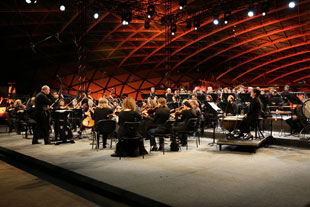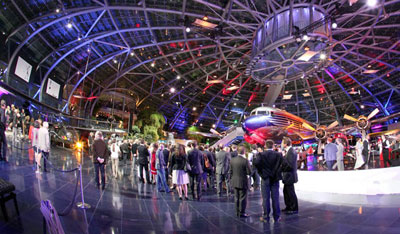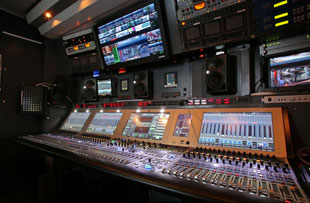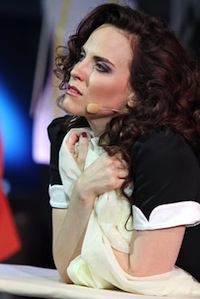![]() A groundbreaking production of Mozart’s Die Entführung aus dem Serail was staged at the Salzburg Festival during in August 2013 – Salzburg Airport’s Hangar-7 and Hangar-8 saw the 18th century story transformed to the present day, and performed for a 650-strong live audience in the round.
A groundbreaking production of Mozart’s Die Entführung aus dem Serail was staged at the Salzburg Festival during in August 2013 – Salzburg Airport’s Hangar-7 and Hangar-8 saw the 18th century story transformed to the present day, and performed for a 650-strong live audience in the round.
With the set and orchestra in different hangars, the audience listened via UHF transmission and moved through the scenery as part of the performance.
 Along with the live audience, ServusTV broadcast the two-and-a-half-hour performance live – which was also recorded using 16 cameras, two Steadicams and a cable cam system – and viewers in 19 other countries were able to tune in via UnitelClassica. In addition, live public screenings were held in Salzburg, Linz and Vienna. The images from outside cameras relayed the scene to the TV viewers. Appropriately, the escape from the Seraglio took place in a helicopter, in keeping with the setting. Even occasional noise from aircraft using the airport played a part.
Along with the live audience, ServusTV broadcast the two-and-a-half-hour performance live – which was also recorded using 16 cameras, two Steadicams and a cable cam system – and viewers in 19 other countries were able to tune in via UnitelClassica. In addition, live public screenings were held in Salzburg, Linz and Vienna. The images from outside cameras relayed the scene to the TV viewers. Appropriately, the escape from the Seraglio took place in a helicopter, in keeping with the setting. Even occasional noise from aircraft using the airport played a part.
The audio for the ambitious production (dubbed ‘Austria’s most complex, prestigious, and important audio event in 2013’ by the host broadcaster) was provided by German company, TVN Mobile Production, in conjunction with Euro TV Production.
‘You have to remember that many of those involved, including the performers, are used to working in an opera house with an infrastructure that has developed over many years,’ says Stephan Thyssen, who has worked for TVN Mobile Production since 1998 and has headed the company’s audio department since 2004. ‘Our job was to fulfil all the requirements, even in a hangar.’
TVN Mobile Production brought in an OB van and equipment truck for the event. The audio from the OB van was mixed separately in a specially-equipped audio container by tonmeister and sound engineer Georg Burdicek (Tonzauber, Vienna) using a Calrec Artemis Beam digital mixing console and a Neumann KH 310 A surround monitor set-up. In the OB control room, a TVN staff picked up the surround feed, and added commentary and atmos for the various broadcast sound requirements.
 The performance took place over an area of 13,700-sq-m, with orchestra and vocalists so far apart that they could neither see nor hear each other without electronic support. The Camerata Salzburg was conducted by Hans Graf played in Hangar-8, while most of the vocalists performed in Hangar-7.
The performance took place over an area of 13,700-sq-m, with orchestra and vocalists so far apart that they could neither see nor hear each other without electronic support. The Camerata Salzburg was conducted by Hans Graf played in Hangar-8, while most of the vocalists performed in Hangar-7.
The hangar doors left ajar during the performance and Burdicek avoided problems with wind noise and reflections from the hangar architecture by careful selection and positioning of the mics. A Decca Tree was used for the main mics, with two Sennheiser MKH 800s mounted on the rig in front of the orchestra as room microphones, and a cardioid Neumann TLM 170 R for the trumpets. All of the spot microphones used for the orchestra were Sennheiser MKH 8040 cardioid mics mounted on signal-carrying bars and fitted with MZW 8000 double-layer windshields. ‘This wind noise protection is extremely effective,’ Burdicek confirms.
Mixing Mozart
TVN had chosen the Calrec Artemis Beam console to handle the 5.1 music mix for the production, along with Calrec Hydra I/O boxes to feed the console.
‘The console exceeded our expectations for sonic performance and patching flexibility, especially in such an intricate and acoustically challenging environment as this one was,’ says Thyssen. ‘The complexity of the event was enormous since this production was not only going live-to-air, but also had to be recorded for a subsequent DVD/Blu-ray release. We were also impressed by the support we got from Calrec throughout the project. The production had so many moving parts, and Calrec allowed us to test the console on short notice and made sure there was someone on site from set-up through rehearsals to broadcast to operate the console and help the production run smoothly.’
The Artemis Beam was used to mix the orchestra from its own audio container with the conductor about 440 yards distant from the singers; the mix the conductor received from FOH had to be independent of the final 5.1 mix and stereo downmix. The console sent the stereo downmix to the conductor, and the FOH mixer added the singers on top, and also played a role in remixing and fault-finding during rehearsals. Every rehearsal was recorded in multichannel as well as stereo format, and mixes were assessed in the mornings to improve details.
Theo Schulte from Berlin-based Arc Studios, Calrec’s representative in Germany, provided on-site support for TVN and also served as the operator: ‘Calrec makes a point of developing close relationships with customers that go far beyond the sale – not only to ensure that we continue developing products that suit them, but also to ensure that they have our full attention and support whenever and wherever they need it,’ says Calrec EMEA Sales Manager, Chas Rowden.
Mics and monitors The conductor and concert master followed the event using in-ear monitors fed from a Sennheiser IEM system. The vocalists in Hangar-7 (around 150m away) were cued by three assistant conductors also equipped with IEM headphones, as the delay caused by digital video transmission would have led to timing problems if a purely image-based process had been used. The five soloists and three actors also used wireless IEM systems. Individual monitor mixes were provided by a digital console located in the side area of the hangar.
The conductor and concert master followed the event using in-ear monitors fed from a Sennheiser IEM system. The vocalists in Hangar-7 (around 150m away) were cued by three assistant conductors also equipped with IEM headphones, as the delay caused by digital video transmission would have led to timing problems if a purely image-based process had been used. The five soloists and three actors also used wireless IEM systems. Individual monitor mixes were provided by a digital console located in the side area of the hangar.
‘The wireless frequencies were arranged in such a way as to avoid conflicts with LTE,’ Burdicek explains.
‘As we were directly at the airport, the use of frequencies was strictly regulated,’ Thyssen elaborates. ‘Nevertheless, we managed to squeeze almost 40 wireless audio channels into a very tight area.’
Particular attention had to be paid to air traffic control communication in the UHF range, while the hangar itself caused problems with harmonic waves. Transmission power was 50mW or 100mW, and 1W boosters were used. The technicians selected ground plane models (Sennheiser GZA 1036 TV) as receiving antennas, and these proved to be the ideal choice in the special environment of Hangar-7.
 A Sennheiser Digital 9000 wireless microphone system was provided for soloists Desirée Rancatore and Tobias Moretti – A5000-CP antennas with AB 9000 antenna boosters were used as receiving antennas and distributed throughout the hangar. The production used six of the eight channels of the EM 9046 multichannel receiver, with two channels kept as spares. Each vocalist was equipped with two transmitters and a wireless IEM receiver. The soloists’ voices were transmitted in the usual double configuration, with the headsets being fitted with Sennheiser MKE 1 microphones.
A Sennheiser Digital 9000 wireless microphone system was provided for soloists Desirée Rancatore and Tobias Moretti – A5000-CP antennas with AB 9000 antenna boosters were used as receiving antennas and distributed throughout the hangar. The production used six of the eight channels of the EM 9046 multichannel receiver, with two channels kept as spares. Each vocalist was equipped with two transmitters and a wireless IEM receiver. The soloists’ voices were transmitted in the usual double configuration, with the headsets being fitted with Sennheiser MKE 1 microphones.
Having completed the broadcast and recording, Burdicek is able to compare analogue and digital wireless transmission: ‘There are significant differences particularly in the representation of the dynamics,’ he says. ‘It is not easy to transmit the voices of opera singers, as their repertoire includes all nuances from very quiet to very loud. In critical passages, you can indeed sometimes hear the integrated compander system in analogue wireless transmission, while this is completely eliminated in a digital system.’
Thyssen was also impressed by the sound of the digital transmission technology: ‘When we build the next OB van with TVN, we will definitely install digital audio signal transmission using the Digital 9000 system from Sennheiser,’ he adds.
More: www.calrec.com
More: www.sennheiser.com
More: www.grothusenav.com